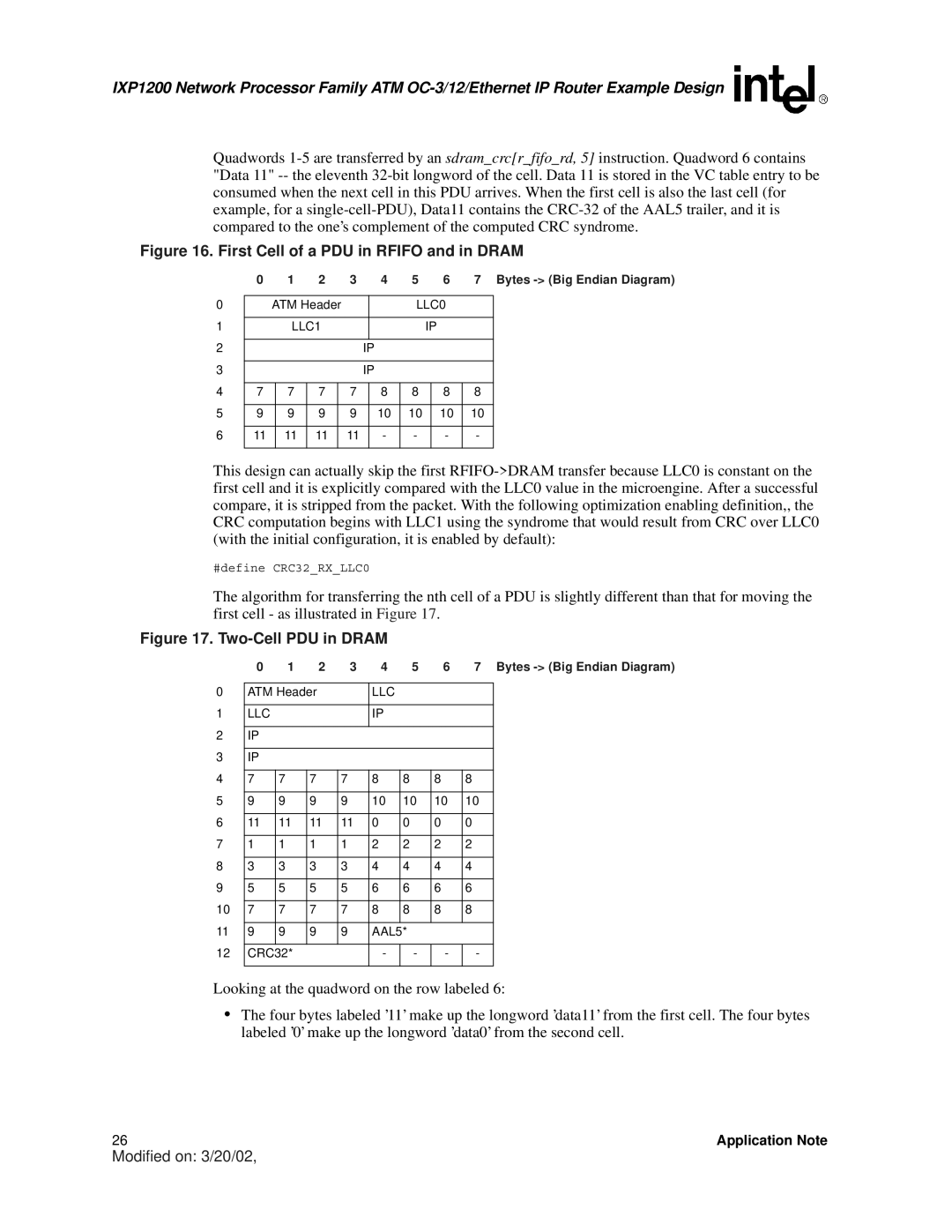IXP1200 Network Processor Family ATM
Quadwords
Figure 16. First Cell of a PDU in RFIFO and in DRAM
| 0 | 1 | 2 |
| 3 | 4 | 5 | 6 | 7 | Bytes | |||
|
|
|
|
|
|
|
|
|
|
|
|
| |
0 |
| ATM Header |
|
|
| LLC0 |
|
| |||||
|
|
|
|
|
|
|
|
|
|
| |||
1 |
|
| LLC1 |
|
|
|
| IP |
|
| |||
|
|
|
|
|
|
|
|
|
|
|
|
|
|
2 |
|
|
|
|
|
| IP |
|
|
|
|
| |
|
|
|
|
|
|
|
|
|
|
|
|
| |
3 |
|
|
|
|
|
| IP |
|
|
|
|
| |
|
|
|
|
|
|
|
|
|
|
|
|
| |
4 | 7 |
| 7 | 7 |
| 7 |
| 8 | 8 |
| 8 | 8 |
|
|
|
|
|
|
|
|
|
|
|
|
|
|
|
5 | 9 |
| 9 | 9 |
| 9 |
| 10 | 10 |
| 10 | 10 |
|
|
|
|
|
|
|
|
|
|
|
|
|
|
|
6 | 11 |
| 11 | 11 |
| 11 |
| - | - |
| - | - |
|
|
|
|
|
|
|
|
|
|
|
|
|
|
|
This design can actually skip the first
#define CRC32_RX_LLC0
The algorithm for transferring the nth cell of a PDU is slightly different than that for moving the first cell - as illustrated in Figure 17.
Figure 17. Two-Cell PDU in DRAM
| 0 | 1 | 2 | 3 | 4 | 5 | 6 | 7 Bytes | |
|
|
|
|
|
|
|
|
|
|
0 | ATM Header |
| LLC |
|
|
|
| ||
|
|
|
|
|
|
|
|
|
|
1 | LLC |
|
|
| IP |
|
|
|
|
|
|
|
|
|
|
|
|
|
|
2 | IP |
|
|
|
|
|
|
|
|
|
|
|
|
|
|
|
|
|
|
3 | IP |
|
|
|
|
|
|
|
|
|
|
|
|
|
|
|
|
|
|
4 | 7 | 7 | 7 | 7 | 8 | 8 | 8 | 8 |
|
|
|
|
|
|
|
|
|
|
|
5 | 9 | 9 | 9 | 9 | 10 | 10 | 10 | 10 |
|
|
|
|
|
|
|
|
|
|
|
6 | 11 | 11 | 11 | 11 | 0 | 0 | 0 | 0 |
|
|
|
|
|
|
|
|
|
|
|
7 | 1 | 1 | 1 | 1 | 2 | 2 | 2 | 2 |
|
|
|
|
|
|
|
|
|
|
|
8 | 3 | 3 | 3 | 3 | 4 | 4 | 4 | 4 |
|
|
|
|
|
|
|
|
|
|
|
9 | 5 | 5 | 5 | 5 | 6 | 6 | 6 | 6 |
|
|
|
|
|
|
|
|
|
|
|
10 | 7 | 7 | 7 | 7 | 8 | 8 | 8 | 8 |
|
|
|
|
|
|
|
|
|
|
|
11 | 9 | 9 | 9 | 9 | AAL5* |
|
|
| |
|
|
|
|
|
|
|
|
|
|
12 | CRC32* |
|
| - | - | - | - |
| |
|
|
|
|
|
|
|
|
|
|
Looking at the quadword on the row labeled 6:
•The four bytes labeled ’11’make up the longword ’data11’from the first cell. The four bytes labeled ’0’make up the longword ’data0’from the second cell.
26 | Application Note |
Modified on: 3/20/02,
